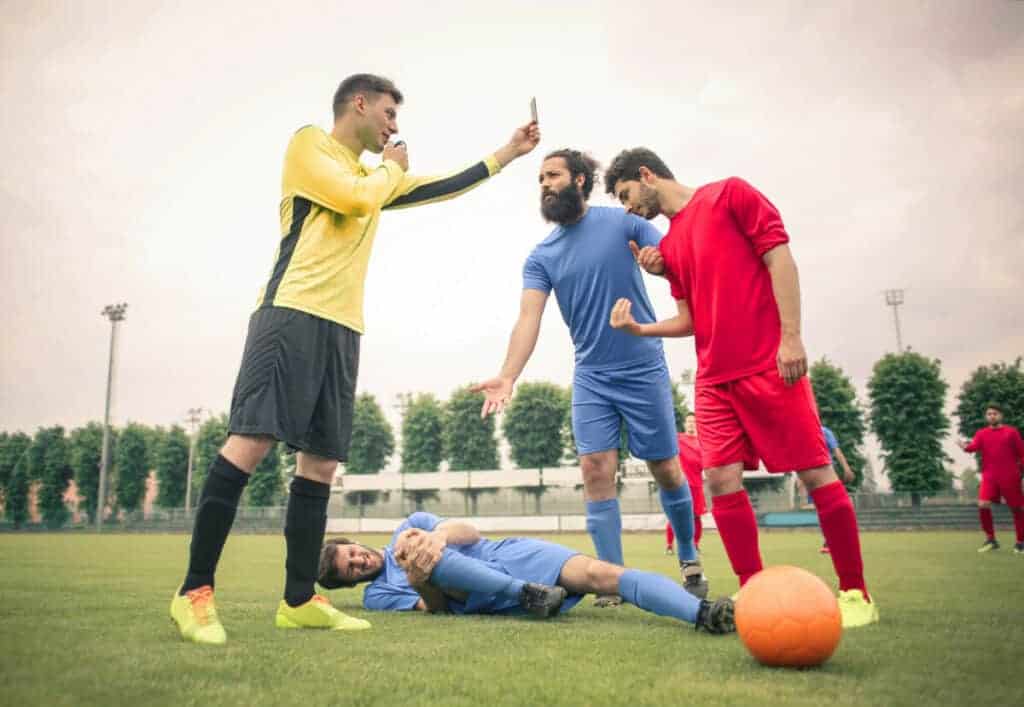Do soccer players fake injuries?
When watching or playing soccer matches, it’s crucial to know the ins and outs of real versus fake injuries in soccer. When are players faking it, and why would they want to pretend to be hurt during a high-stakes game? After doing extensive research, it’s clear that soccer players do indeed fake injuries occasionally but will also get genuinely hurt during some games.

Soccer players fake injuries often during games. Players do this to catch the attention of the referee, try to make an opportunity to score a goal on the other team, waste time, attempt to regain possession of the ball, or punish another player.
What makes both real and fake injuries so interesting in soccer? Why are so many injuries faked during the game? Let’s go over what to look for in case an injury occurs in near-future soccer games!
Why Injury Faking Happens So Often in Soccer
Long story short, faking injuries is seen so often in soccer because it’s helpful! Surprisingly, it can be advantageous to an individual player, or even beneficial for their whole team if they fake an injury in the game. Soccer injuries have practically become a joke of the game since they’ve been around so long, but they are still around for valid reasons.
Players commonly fake injuries while playing soccer because they want to catch the attention of the referee, are trying to create a goal-scoring opportunity, are trying to waste time, try to get possession of the ball back, or are trying to punish a player on the opposing team.
Why Players Fake Injuries

This all may seem farfetched, but players have valid reasons to pretend to be down for the count. First off, one of the most popular and simple reasons why a player will fake getting injured is to draw the attention of the referee to themselves. The player earnestly wants the referee’s game-changing decisions to be made in their favor, so this is where “flopping” and other fake injuries come in.
If a player thinks they’ve been wronged in the game, or want to gain an advantage over the other team, they’ll want the referee to know it, so they’ll fake an injury or flop in a way that the ref cannot ignore. Studies have even shown that a player flopping near the referee is three times more likely to have a decision go their way than if the ref were far away from the player, so it can be worth it.
A player may also simulate an injury to create an opening for an opportunity to score a goal on the opposition. If a player has the ball near the opponent’s goal but isn’t able to make an opportunity to take a shot at it, they might just decide to pretend to be hurt before any potential opportunity is gone.
The hope is that the referee will think that the player has been hurt by an opposing member of the other team, and will award the ‘hurt’ player with a set piece near the opposing team’s goal. Getting this set-piece would provide an excellent chance for one team to score a goal on the other. It may come in the form of a free-kick or a penalty against the opposing team that can really impact the course of the game.

In order to run down time on the game clock, a player might just flop or pretend to be incapacitated. During soccer matches, the game clock doesn’t ever stop, regardless of what’s happening in the game. Should there be delays or stoppages in the game, the referee then adds more time onto the clock at the end of the half.
The extra time added to the match is usually inaccurate, but players still try to fake injuries to stop the play for as long as they can. Wasting time is useful when a team is in the lead, when the game is tied, or if one team wants to prevent the other side from being able to score, period.
Finally, players could also fake out in order to get possession of the soccer ball back after losing it to the other team. Often, this happens right after a player has been tackled or has lost possession of the ball to the other team. They’ll flop immediately or ‘fall down’ due to a simulation of an injury. They also hope that the ref will pause the game and award possession of the ball to the player who originally had the ball.
What is Flopping

Flopping is when a player embellishes or exaggerates a foul, or is pretending to be fouled when none was committed in order to try to deceive and trick the referee. A ref who spots the deception can punish the offending player with a yellow card.
Sports spectators who focus on players in possession of or closest to the ball will likely see this move firsthand. Sometimes honest injuries will happen because players on the field are running at impressively fast speeds, with a lot of physical strength sending them sprawling if they get tripped up or fall, so don’t assume all injuries are a sham. But, when faked injuries inevitably come up, now we know why!
Punishment for Faking Injuries
Faking in soccer doesn’t come without its risks. Match rules dictate that players will be warned for unsportsmanlike behavior, should the player try to deceive the referee by feigning injury or pretending to have been fouled or injured by an opposing player. Being warned means that the player will be shown a yellow card, which is another step closer to being taken out of the game entirely.
Interestingly, a soccer player cannot get a red card for diving in the game. Should they earn a red card following a diving move, it would be because they’ve already been shown a yellow card before. After getting a second yellow card for their dive, they’re then shown a red card as punishment for earning two yellow cards in a single game. Yellow cards are serious disciplinary actions, and one that players may anticipate if they’re going to be gutsy enough to try to trick a ref.
